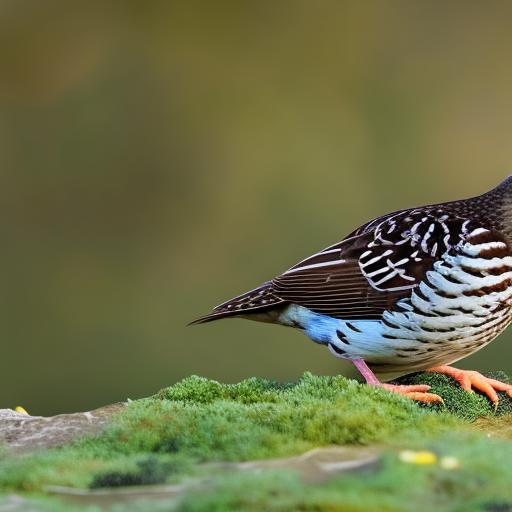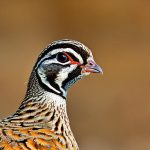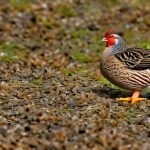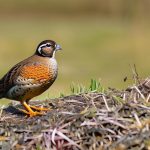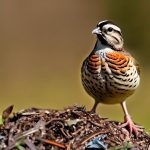The Chinese Painted Quail, also known as the King Quail or Button Quail, is a small and colorful bird native to Southeast Asia. These tiny birds are popular among avian enthusiasts for their vibrant plumage and charming personalities. Chinese Painted Quail are often kept as pets or for breeding purposes due to their small size and relatively low maintenance requirements. They are also known for their distinctive call, which sounds like a series of high-pitched whistles. These birds are social creatures and are best kept in pairs or small groups to prevent loneliness and encourage natural behaviors. Chinese Painted Quail are generally hardy and adaptable, making them suitable for both novice and experienced bird keepers.
Chinese Painted Quail come in a variety of color mutations, including silver, cinnamon, blue, and white, making them a visually appealing addition to any aviary or household. Their small size, measuring around 4-5 inches in length, makes them ideal for those with limited space. These birds are ground-dwellers and are often found foraging for seeds and insects in their natural habitat. In captivity, they require a suitable enclosure with plenty of space to roam and explore. Overall, Chinese Painted Quail are delightful and fascinating birds that can bring joy and entertainment to their owners.
Key Takeaways
- Chinese Painted Quail, also known as King Quail, are small, colorful birds native to Asia and Australia.
- They require a spacious enclosure with plenty of hiding spots and soft bedding material.
- A balanced diet of seeds, greens, and protein is essential for their health and well-being.
- Regular health check-ups and a clean environment are crucial for preventing common health issues.
- Breeding Chinese Painted Quail requires careful monitoring of nesting behavior and providing a suitable breeding environment.
Housing and Enclosure Requirements
When it comes to housing Chinese Painted Quail, it’s important to provide them with a suitable enclosure that meets their specific needs. A spacious aviary or cage is essential to ensure these birds have enough room to move around and exercise. The enclosure should be constructed with solid walls to prevent drafts and should be placed in a quiet area away from excessive noise and disturbances. The flooring of the enclosure should be covered with a soft substrate such as sand or wood shavings to mimic their natural environment and allow for natural behaviors like dust bathing.
In addition to space, Chinese Painted Quail require access to fresh air and natural light. The enclosure should have adequate ventilation to maintain good air quality and prevent the buildup of harmful fumes. Natural light is also important for the well-being of these birds, so placing the enclosure near a window or providing full-spectrum lighting can help mimic the effects of sunlight. It’s also crucial to include hiding spots and shelter within the enclosure to allow the quail to retreat and feel secure when needed. Providing branches, perches, and other forms of enrichment can also help keep these birds mentally stimulated and physically active.
Diet and Nutrition
Proper nutrition is essential for the health and well-being of Chinese Painted Quail. In the wild, these birds primarily feed on a diet of seeds, insects, and vegetation. In captivity, it’s important to replicate this natural diet by offering a high-quality commercial game bird feed supplemented with fresh fruits, vegetables, and protein sources. The game bird feed should contain a balanced mix of seeds, grains, and vitamins to meet the nutritional requirements of the quail. Additionally, offering a variety of fresh foods such as leafy greens, carrots, and mealworms can provide essential nutrients and prevent boredom.
Fresh water should always be available to Chinese Painted Quail, provided in a shallow dish or waterer that is easily accessible. It’s important to regularly clean and refill the water container to ensure it remains free of contaminants and debris. Additionally, offering grit or crushed oyster shell can help aid in digestion and provide essential minerals for these birds. Monitoring their food intake and adjusting portion sizes as needed is crucial to prevent obesity or malnutrition. Overall, a well-rounded diet consisting of commercial feed, fresh produce, and supplemental protein sources is key to maintaining the health and vitality of Chinese Painted Quail.
Health and Wellness
Maintaining the health and wellness of Chinese Painted Quail is essential for their overall quality of life. Regular veterinary check-ups are recommended to monitor their health status and address any potential issues early on. It’s important to observe their behavior and appearance daily to detect any signs of illness or distress. Common health concerns for Chinese Painted Quail include respiratory infections, parasites, and nutritional deficiencies. Providing a clean and hygienic environment, along with a balanced diet, can help prevent many health problems.
In addition to physical health, mental stimulation is also important for the well-being of Chinese Painted Quail. Providing enrichment such as perches, hiding spots, and toys can help prevent boredom and encourage natural behaviors. Regular exercise is also crucial for these birds, so providing ample space for them to move around and explore is essential. Maintaining a stable environment with proper temperature and humidity levels can also contribute to their overall well-being. By prioritizing both physical and mental health, owners can ensure that their Chinese Painted Quail lead happy and fulfilling lives.
Breeding and Reproduction
Breeding Chinese Painted Quail can be a rewarding experience for avian enthusiasts. These birds reach sexual maturity at around 6-8 weeks of age, at which point they may begin to display courtship behaviors such as calling, preening, and chasing. When breeding Chinese Painted Quail, it’s important to provide a suitable nesting area within the enclosure. This can be achieved by offering a shallow dish filled with soft nesting material such as hay or shredded paper. The female quail will lay eggs in the nesting area, typically laying one egg per day until she has completed her clutch.
Once the eggs are laid, it’s important to provide a quiet and secure environment for the nesting pair. The eggs should be left undisturbed, as excessive handling can disrupt the incubation process. Chinese Painted Quail eggs typically hatch after 16-18 days of incubation, at which point the chicks will require warmth and protection from their parents. Providing a heat source such as a heat lamp or heating pad can help maintain the ideal temperature for the chicks to thrive. Additionally, offering a high-protein diet to the growing chicks can support their development and growth. With proper care and attention, breeding Chinese Painted Quail can result in healthy offspring that will bring joy to their owners.
Handling and Socialization

Chinese Painted Quail are generally shy and skittish birds that may not readily tolerate handling. However, with patience and gentle socialization, they can become more comfortable with human interaction over time. It’s important to approach these birds calmly and avoid sudden movements or loud noises that may startle them. Offering treats such as mealworms or millet can help build trust and encourage positive associations with human contact.
When handling Chinese Painted Quail, it’s important to support their body securely and avoid grabbing or restraining them forcefully. Cupping them gently in your hands or allowing them to perch on your finger can help minimize stress and make the experience more pleasant for both the bird and the handler. It’s also important to limit handling to short periods of time to prevent overwhelming the quail. By gradually acclimating them to human interaction and respecting their boundaries, owners can build a trusting relationship with their Chinese Painted Quail.
Common Behavioral Traits and Characteristics
Chinese Painted Quail are known for their active and inquisitive nature. These birds are ground-dwellers that enjoy foraging for food and exploring their surroundings. They are social creatures that thrive in pairs or small groups, so providing companionship is important for their well-being. These birds are also known for their distinctive call, which consists of high-pitched whistles that they use to communicate with each other.
In addition to their social nature, Chinese Painted Quail are also known for their agility and speed. They are quick on their feet and can dart around their enclosure with ease. Providing ample space for them to move around and exercise is essential to prevent boredom and encourage natural behaviors. These birds are also known for their colorful plumage, which varies depending on the specific color mutation. Their vibrant feathers make them visually striking additions to any aviary or household.
Overall, Chinese Painted Quail are delightful birds with unique characteristics that make them fascinating pets or breeding subjects. By understanding their specific needs and behaviors, owners can provide a suitable environment that allows these birds to thrive and flourish.
If you’re interested in keeping Chinese painted quail, you may also want to explore the topic of raising chickens. Poultry Wizard offers a helpful article on “How Many Chickens Do You Need for a Family of 4?” which provides valuable insights into determining the ideal number of chickens for your household. This article can be found here. Understanding the needs and dynamics of different poultry species can enrich your knowledge and experience in animal husbandry.
FAQs
What are Chinese painted quail?
Chinese painted quail, also known as button quail, are small ground-dwelling birds native to East Asia. They are popular as pets due to their small size and colorful plumage.
What do Chinese painted quail eat?
Chinese painted quail are omnivorous and eat a variety of foods including seeds, insects, and small plants. In captivity, they can be fed a diet of commercial game bird feed, supplemented with fresh fruits and vegetables.
How big do Chinese painted quail grow?
Chinese painted quail are small birds, typically growing to be around 4-5 inches in length.
What kind of habitat do Chinese painted quail need?
Chinese painted quail require a habitat with plenty of ground space to forage and explore. They also need access to a shallow dish of water for drinking and bathing.
Are Chinese painted quail social animals?
Chinese painted quail are social birds and are best kept in small groups. However, they can be territorial, so it’s important to provide enough space for each bird.
What are some common health issues for Chinese painted quail?
Common health issues for Chinese painted quail include respiratory infections, parasites, and injuries from rough handling or inadequate housing. It’s important to provide a clean and stress-free environment to prevent these issues.
Meet Walter, the feathered-friend fanatic of Florida! Nestled in the sunshine state, Walter struts through life with his feathered companions, clucking his way to happiness. With a coop that’s fancier than a five-star hotel, he’s the Don Juan of the chicken world. When he’s not teaching his hens to do the cha-cha, you’ll find him in a heated debate with his prized rooster, Sir Clucks-a-Lot. Walter’s poultry passion is no yolk; he’s the sunny-side-up guy you never knew you needed in your flock of friends!

